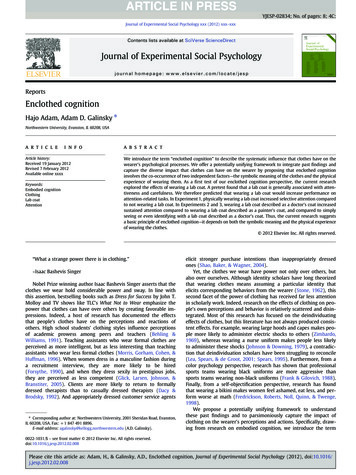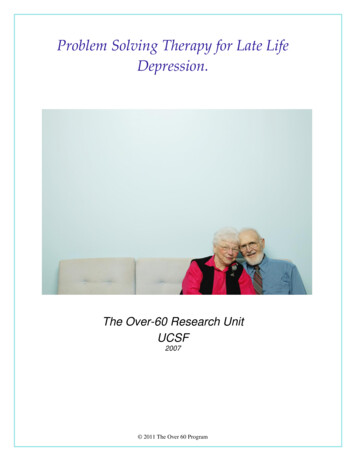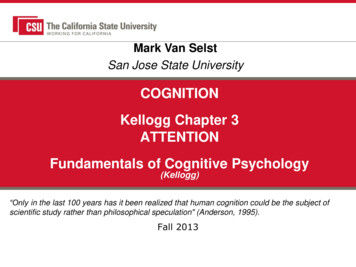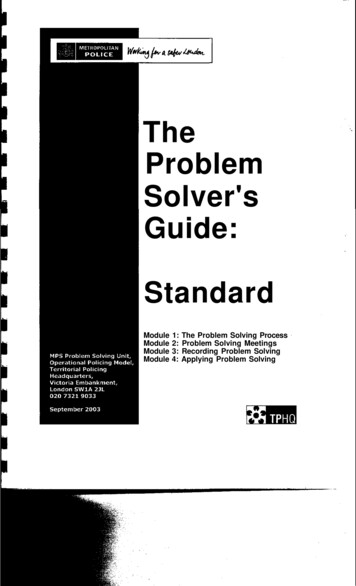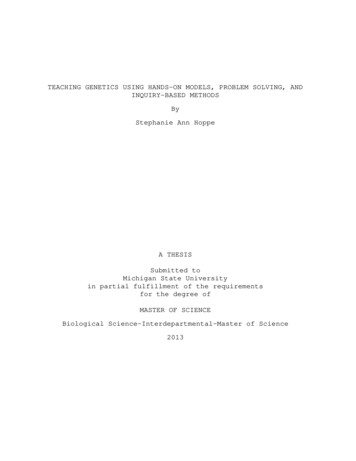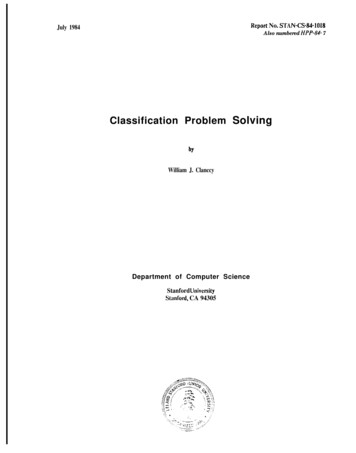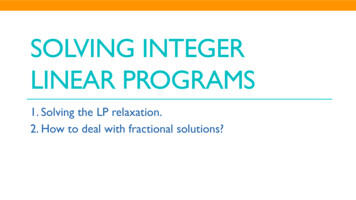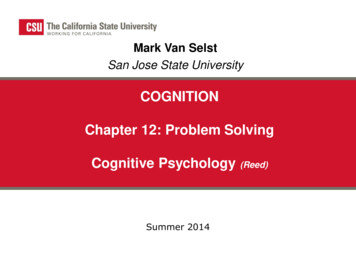
Transcription
Mark Van SelstSan Jose State UniversityCOGNITIONChapter 12: Problem SolvingCognitive PsychologySummer 2014(Reed)
Defining a problemThere is a problem when a goal is not immediatelyable to be achieved (e.g., Reitman, 1965; Newell &Simon, 1972).Problem-solving is the identification and selectionof solutions to the problem.CognitionVan Selst (Reed Chapter 12)
Problem SolvingDirected and Undirected Thinking Directed: Goal-oriented and rational Requires a clear well-defined goal Undirected: Meanders (day dreams,dreaming, drifting thoughts, etc.) Plays a role in creativity and poorly-definedproblemsWell-Defined and Ill-Defined ProblemsCognitionVan Selst (Reed Chapter 12)
Separating Problems by the skillsneeded to solve them (Greeno)Greeno (1978) proposes that problems bearranged into three types: ( combinations) ARRANGEMENT (anagrams, Luchin’s water jug): requires the problem solver to organize the objectsinto a way that satisfies some criterion INDUCING STRUCTURE (reasoning by analogy) Requires the problem-solver to rearrange objects insome way that forms a new relation among them TRANSFORMATIVE (tower of Hanoi; missionaries) Initial State, Goal State, Sequence of Operations(these define the problem space)
Arrangement Problems A Problem that requires rearranging its parts tosatisfy a specified criterion e.g., ANAGRAM: rearranging a string of letters to form a word orwords (KEROJ ?; RWAET ?) Solving an arrangement problem often involves alot of trial and error during which partial solutionsare formed and evaluated. Dependent on: Fluency (generating possibilities),Retrieval of Solution Patterns, Knowledge ofprinciples that constrain the search (e.g., JRunlikely)Van Selst (Reed Chapter 12)
Inducing StructureChessboard / Domino Problem (Mutilated Chessboard Problem)We have a chessboard withthe two opposing cornersremoved, so that there areonly 62 squares remaining.Now we take 31 dominoesshaped such that eachdomino covers exactly twosquares. The question is: isit possible to arrange the 31dominoes so that theycover all 62 squares on thechessboard?CognitionXVan Selst (Reed Chapter 12)X
Tower Of Hanoi(Transformative / well-defined problem)Move from start state to end state by moving one disk at a time, and neverplacing a smaller disk on a larger disk.Initial StateGoal StateWell-Defined ProblemGoal State (clear)Initial State (clear)Subgoals (problem can be broken down)Problem Space (all possible legal moves [operators])CognitionVan Selst (Reed Chapter 12)
Problem Space(Newell & Simon)all possible legal movesEach legal move from the initial state to someintermediate state is specifically defined by anOPERATOR.Solve for x:CognitionVan Selst (Reed Chapter 12)
Tower Of Hanoi(the problem space)Well-Defined Problem Goal State, Initial State, Subgoals, Problem Space GoalStateall possible legal moves (operator actions)CognitionVan Selst (Reed Chapter 12)
Missionaries andCannibals (transformative)start Your task is to take 3missionaries and 3cannibals across theriver. The boat holds 2. The cannibals mustnever outnumber themissionaries (or theywill eat them).finishCognitionVan Selst (Reed Chapter 12)
Ill-Defined Problems How do you advance in your chosen career? What is the goal state? What is your current state (initial state) What are the intermediate goals (subgoaldecomposition) What are all possible operations [OPERATORS]that could be employed (i.e., what is the problemspace?)CognitionVan Selst (Reed Chapter 12)
Where we are atWell-defined problems Your car doesn’t start in the morning and you want to tryand find out what’s wrong with it You want to beat an opponent at chess You want to find a street in an unfamiliar cityIll-defined problems You want to be happy You want to be successful Draw a picture Write an essayCognitionVan Selst (Reed Chapter 12)
Productive and ReproductiveProblem SolvingThe GESTALT approach to problem solvingdifferentiates between:Productive Thinking insight and creativityReproductive Thinking following a sequence known to produce aworkable answerCognitionVan Selst (Reed Chapter 12)
Gestalt approach toproblem-solvingAdapted their problem-solving approach fromperception. Perception inherently involvesrestructuring. Two views of Necker cube seen by restructuringimage to see as “right” or “left”Person often has to restructure a problem inorder to gain insight into its solutionCognitionVan Selst (Reed Chapter 12)
Insightproblem solving in monkeys: Kohler (1927)Monkeys showed “insight” duringproblem-solving. Demonstrated productive “newway of structuring elementsshowing insight and creativity” Deep useful understanding of thenature of the problem versus trial-and-error (a.k.a.,reproductive // tried and true //rule-based) problem solving (e.g.,of the cat-in-the-box of Thorndike,1898).Solved problems by using tools.Sultan stacks boxes to reachbananas.CognitionVan Selst (Reed Chapter 12)AH-HA!
Gestalt approach to problem-solvingTHE CANDLE PROBLEM (Dunker, 1945) Fix lit candle to wall, with candle, box of nails & box of matches.THE TWO-STRING PROBLEM (Maier, 1931).Subjects in room with 2 strings hanging from ceiling and set of otherobjects (nut, bowl, pliers, sandwich, ).- Task is to attach the strings. However, cannot reach them atsame time.WATER-JUG PROBLEM The subject is given a set of jugs of various stated capacities,and is asked to measure out a desired quantity of waterNINE-DOT PROBLEM (Scheerer, 1931) Connect all nine dots by drawing four continuous lines?CognitionVan Selst (Reed Chapter 12)
Duncker’s (1945) Candle Problem(Functional Fixedness) Participants were provided a candle, abox of nails, and several other objects,and asked to attach the candle to thewall so that it did not drip onto the tablebelow. Participants tried to nail the candledirectly to the wall or to glue it to thewall by melting it. Very few thought ofusing the inside of the nail box as acandle-holder and nailing this to thewall. The participants were “fixated” on thebox’s normal function of holding nailsand could not reconceptualize it in amanner that allowed them to solve theproblem.CognitionVan Selst (Reed Chapter 12)
Duncker’s (1945) Candle Problem(Functional Fixedness) Participants were provided a candle, abox of nails, and several other objects,and asked to attach the candle to thewall so that it did not drip onto the tablebelow. Participants tried to nail the candledirectly to the wall or to glue it to thewall by melting it. Very few thought ofusing the inside of the nail box as acandle-holder and nailing this to thewall. The participants were “fixated” on thebox’s normal function of holding nailsand could not reconceptualize it in amanner that allowed them to solve theproblem.CognitionVan Selst (Reed Chapter 12)
The Two-String ProblemCognitionVan Selst (Reed Chapter 12)
Functional FixednessBirch and Rabinowitz (1951) adapted the two-cord problem from Maier (1930,1931), where subjects would be given 2 cords hanging from the ceiling, and2 heavy objects in the room.They are told they must connect the cords, but they are just far enough apartthat one cannot reach the other easily.The solution was to tie one of the heavy objects to a cord and be a weight, andswing the cord as a pendulum, catch the rope as it swings while holding on tothe other rope, and then tie them together.The participants are split into 3 groups: Group R, which completes a pretask of completing an electrical circuit byusing a relay Group S, which completes the circuit with a switch and Group C which is the control group given no pretest experience.Group R participants were more likely to use the switch as the weight, andGroup S were more likely to use the relay. Both groups did so because theywere previous experience led them to use the objects a certain way, andfunctional fixedness did not allow them to see the objects as being used foranother purpose.CognitionVan Selst (Reed Chapter 12)
the water-jug experiment(Luchin 1942, 1959)The subject is given a set of jugs of various stated capacities,and is asked to measure out a desired quantity of water.ProblemCapacityJug ACapacityJug BCapacityJug ognitionVan Selst (Reed Chapter 12)
the water-jug experiment(Luchin 1942, 1959)All problems except 8 can be solved by B - 2C - A.For problems 1 through 5 this solution is simplest.For problem 7 and 9 the simpler solution is A C.Problem 8 cannot be solved by B - 2C - A, but can be solved by A - C.Problems 6 and 10 can be solved more simply as A - C.Subjects who worked through all problems in order:83% used B- 2C - A on problems 6 and 7.64% failed to solve problem 8.79% used B - 2C - A on problems 9 and 10.Subjects who saw only last 5 problems.Fewer than 1% used B - 2C - A.Only 5% failed to solve problem 8.Problem can be overcome by warning subjects.After problem 5, Lurchins told some subjects “Don't be blind”, which causedmore than 50% to find the simpler solution on the remaining problems.CognitionVan Selst (Reed Chapter 12)
Gestalt approach toproblem-solvingTHE CANDLE PROBLEM (Dunker, 1945) Functional Fixedness: limited by thinking about the normalfunctional uses of an objectTHE TWO-STRING PROBLEM (Maier, 1931). Functional Fixedness: limited by thinking about the normalfunctional uses of an objectWATER-JUG PROBLEM Fixation occurs when solver is fixated on wrong approach to problem. Itoften is result of past experience. Fixation refers to the blocking of solution paths to a problem that iscaused by past experiences related to the problem NEGATIVE SET (set effects) - bias or tendency to solve a problem aparticular wayNINE-DOT PROBLEM (Scheerer, 1931) fixation, negative setCognitionVan Selst (Reed Chapter 12)
Restructuring UsingAnalogies (Duncker, 1945) One special kind of restructuring (Inducing Structure), is analogicalproblem solving. To find a solution to one problem - the so called target problem, ananalogous solution to another problem - the source problem, ispresented.As a doctor you have to treat a patient with a malignant, inoperabletumor, buried deep inside the body. There exists a special kindof ray, which is perfectly harmless at a low intensity, but at thesufficient high intensity is able to destroy the tumor - as well asthe healthy tissue on his way to it. What can be done to avoid thelatter?When this question was asked to participants in an experiment, most ofthem couldn't come up with the appropriate answer to the problem.Then they were told a story that went something like this:CognitionVan Selst (Reed Chapter 12)
Reasoning by AnalogyThis is the “source” problemIn this case it is an ISOMORPH of the “target” problemA General wanted to capture his enemy's fortress. He gathered a largearmy to launch a full-scale direct attack, but then learned, that all theroads leading directly towards the fortress were blocked by mines.These roadblocks were designed in such a way, that it was possible forsmall groups of the fortress-owner's men to pass them safely, but everylarge group of men would initially set them off. The General divided histroops into several smaller groups and made each of them march downa different road, timed in such a way, that the entire army would reuniteexactly when reaching the fortress and could hit with full strength.Note that superficial similarities can cause people to attempt to use similarsolutions but may not detect isomorphs when presented with models from otherdomains.CognitionVan Selst (Reed Chapter 12)
Newell and Simon’sGeneral Problem Solver (GPS) Information processing view (information passedthrough a system Restricting to computer programing meantsurfacing assumptions and steps The hope was that it might assist with recursivelyproviding a better model of human problemsolving (informed by verbal report to guideprogramming) Constraints include both task and operatorcharacteristics. Operator characteristics include:STM/LTM Capacity, storage, and retrieval time.
Problem-Solving Strategy:Means-End analysis (heuristic) Identify difference between current & goal state. Create sub-goal & select operator that achieves it. If operator cannot be applied then use means-endanalysis recursively (i.e. repetitively) to removeblocking conditions. Newell and Simon’s GPS forms a reasonablemodel of how people go about solvingtransformational problemsCognitionVan Selst (Reed Chapter 12)
Novice vs. Expert ProblemSolving Backwards Chaining (working backwards) working back from the end state until reachingthe origin state. This is common for noviceproblem-solvers in the domain (also used byexperts). Forwards Chaining (working forwards). Expertsare much more likely to start from the origin pointand move forward whenever the problem strikesthem as readily solvable.CognitionVan Selst (Reed Chapter 12)
10 suggestions for improvingproblem solving1.2.3.4.5.6.7.8.9.Increase domain knowledgeAutomate some componentsFollow a systematic planDraw inferencesDevelop subgoalsWork backwards (if the goal state is well-defined)Search for contradictionsSearch for relations among problems (analogies)Find a difference problem representation (diagram) Think of the chess board / dominoes vs. slices of bread10. Practice! (learn general strategies to approachproblems with)CognitionVan Selst (Reed Chapter 12)
Key Terms (partial list) Directed / undirectedthinking Well / ill –definedproblems Initial state Goal state Subgoal Operator Problem space (Re)Productive thinkingCognition Isomorphic ncubationVerificationFunctional fixednessNegative setfixationVan Selst (Kellogg Chapter 9)
Assignment #10(Biases in Reasoning and Decision Making):GOAL: To have you demonstrate your grasp three different cognitive biases in decisionmaking. One of these must be the "Anchoring and Adjustment" heuristic; another mustrelate to the work of Kahneman. The remaining one is any cognitive biases indecision-making not already included in your write-up that was discussed in class orwhich is mentioned in the text (group think, framing, etc.).REQUIREMENT: Write a report discussing the heuristics that have influenced threeseparate decisions that you have personally made. Provide a brief description of eachof three scenarios in which you had to make a decision (or were involved in thedecision making) and the cognitive biases that may have been involved (possibly inretrospect). Each of the three sections of this assignment will include a clear definitionof the heuristic(s), the description of the situation, and statements that indicate whyeach heuristic applies to the situation as you have described it. It is possible (but notrequired) that multiple heuristics may have influenced each decision; you may notethis, but you must describe three separate decision-making episodes. One of theepisodes must use the "anchoring and adjustment" heuristic, another as discussed byKahneman. The other heuristic is up to you.Cognition
Copyright 2013 / Van Selstwww.calstate.eduwww.sjsu.edu/psych
For problems 1 through 5 this solution is simplest. For problem 7 and 9 the simpler solution is A C. Problem 8 cannot be solved by B - 2C - A, but can be solved by A - C. Problems 6 and 10 can be solved more simply as A - C. Subjects who worked through all problems in order: 83% used B- 2C - A on problems 6 and 7. 64% failed to solve problem 8.


